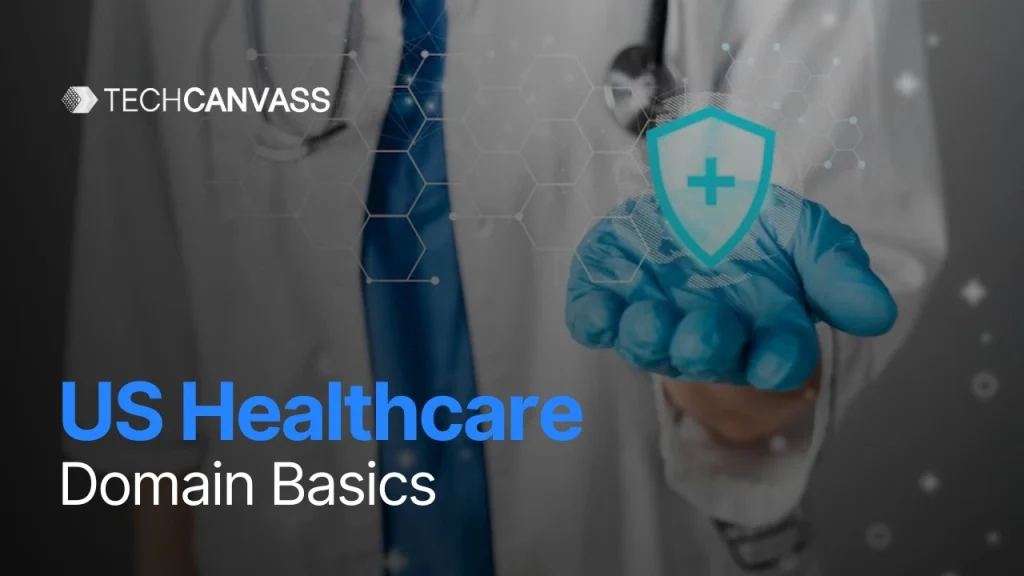Last Updated on September 18, 2025 by Techcanvass Academy
Table of Contents
Overview
The US healthcare domain is a complex system that has a rich history, numerous regulations, multiple payment options and is constantly evolving. Gaining a solid understanding of US healthcare knowledge is important because it helps people and professionals navigate this important sector.
In this blog, we’ll look at the foundations of the US healthcare domain and explore its most significant aspect.
Background
Early Medical Practices (Colonial Era):
- During the Colonial Era, healthcare was heavily influenced by Native American and Indigenous healing practices.
- Midwives and traditional healers played a crucial role in providing healthcare services to communities.
19th Century:
- The formalization of medical education and the major expansion of medical schools occurred in the 19th century.
- Early public health regulations were significantly shaped by epidemics like cholera and smallpox.
Early 20th Century:
- The release of the Flexner Report in 1910 initiated the standardization and reform of medical education.
- Industrial employers began offering health insurance plans as incentives to attract workers.
World War I and World War II:
- Wartime medical advancements, including the discovery of penicillin, had far-reaching effects on civilian healthcare.
- The healthcare workforce expanded, with nurses playing an increasingly vital role.
1960s and 1970s:
- In the 1960s and 1970s, they set up community health centers, SO More people could afford healthcare because they got better insurance, and this made them use more healthcare services.
- This is why healthcare costs went up. At the same time, Medicare and Medicaid began, and this made it much easier for people to get healthcare.
1980s and 1990s:
- The 1980s AIDS crisis had a significant impact on public health regulations and raised awareness of infectious diseases.
- Health Maintenance Organizations (HMOs) and managed care organizations both saw significant expansion.
Recent Years:
- Telemedicine and digital health technology have become more common, allowing patients to confer with healthcare providers remotely, particularly during the COVID-19 epidemic. This has enhanced access to care and convenience.
- Healthcare reform arguments continue, including the fate of the Affordable Care Act and plans for expanding access and lowering prices. Healthcare data analytics has grown in popularity, assisting clinicians in making data-driven decisions to improve patient outcomes and operational efficiency.
- The use of electronic health records (EHRs) has also increased, allowing for the digital storage and sharing of patient health information among healthcare professionals.
Challenges and Controversies:
- Persistent challenges include healthcare disparities and the ongoing efforts to address them, as well as concerns about the influence of pharmaceutical companies on drug pricing and marketing.
- Additionally, medical malpractice lawsuits and discussions surrounding tort reform remain topics of interest.
- Ethical debates continue to unfold, particularly in areas related to end-of-life care and physician-assisted suicide.
Useful Links – US Healthcare Domain Training program | BFSI: Banking, Financial Services and Insurance
How does the US healthcare domain work?
People in the United States take care of their medical expenditures using health insurance companies with various plans. Some people receive government help, but not everyone is eligible. It’s a mix of commercial insurance companies selling plans for a price and the government administering programs to help seniors and low-income people with healthcare bills, which frequently include healthcare facilities. They comprise the United States’ healthcare system.
Health Insurance Providers: There are private companies that offer health insurance. These are like businesses that sell plans to individuals and employers. They create different types of plans with different prices and coverage options.
Getting Health Insurance: Lots of folks obtain health insurance from their employers. The company chips in for a piece of it, and the employees cover the rest. If they don’t get it at work, some individuals purchase health insurance independently.
Paying Premiums: To have health insurance, you need to pay a monthly fee called a premium. It’s like a membership fee. You pay this whether you use the insurance or not.
Doctor Visits: For a doctor’s visit, there could be a copayment, which is a small fee. Part of the cost is covered by the insurance company as well.
Hospitals: When you need the hospital, your insurance steps in to help pay for the major expenses. They partner with specific hospitals, so you may need to visit one of those to receive the fullest assistance.
Private Entities: These are businesses like insurance companies. They create health insurance plans and sell them to people and employers. People pay monthly fees, called premiums, to these private companies for coverage. Private hospitals and doctors also provide medical care, and they may have contracts with insurance companies to accept their plans.
Public Entities: The government is also involved. It has programs like Medicare and Medicaid. Funded by citizens’ taxes, government programs such as Medicare for those aged 65 and older and Medicaid for low-income individuals and families help cover medical expenses. Government-owned hospitals and clinics often cater to individuals in these programs, ensuring access to healthcare services.
Law and Regulations
Affordable Care Act of 2010 (ACA): In 2010, the Affordable Care Act, or Obamacare made it simpler for people to access healthcare, manage healthcare expenses, and ensure that healthcare quality is high. This law also pushed doctors and hospitals to improve how they care for patients. Some key actions it took were creating specific spots where folks could purchase health insurance, assisting more folks with lower incomes in getting Medicaid, and requiring most individuals to have health insurance or face a penalty. It also stated that insurance firms couldn’t reject individuals due to health issues.
Children’s Health Insurance Program (CHIP): CHIP and Medicaid team up to guarantee that children from low-income families can have health insurance, making it easier for them to visit the doctor when necessary.
Patient Safety and Quality Improvement Act (PSQIA) of 2005: In 2005, the PSQIA law was made to keep patients safe and help doctors and hospitals learn from mistakes. It made special groups called patient safety organizations (PSOs) that collect and study data about patient safety. This law also protects doctors and hospitals from getting in trouble when they report mistakes. It’s all about making healthcare safer and better.
Health Insurance Portability and Accountability Act (HIPAA) of 1996: HIPAA is like a guardian for your medical details. It makes sure you can still have health insurance even if you switch jobs or get sick. It stops insurance companies from saying no to you because of your health.
The Health Information Technology for Economic and Clinical Health (HITECH) Act: HITECH helps doctors use computers for their health records. It also makes sure doctors and hospitals keep your health info safe. If they don’t, they can get in trouble.
Medicaid: Medicaid is a program that offers health insurance to those with low incomes, such as pregnant women, children, and people who are unable to work due to disease. It helps a large number of people who seek healthcare coverage.
Healthcare Quality Improvement Act of 1986 (HCQIA): In 1986, HCQIA was established to shield doctors and hospitals when discussing ways to improve their work. This means doctors can openly address issues without the fear of legal action. This makes healthcare safer because doctors can learn from each other.
Medicare: In 1965, Medicare started helping older Americans by acting like health insurance. It paid for their visits to the hospital and appointments with doctors, making sure older folks got the medical care they needed.
Emergency Medical Treatment and Labor Act (EMTALA): In 1986, the EMTALA law came into effect, making it a requirement for hospitals to provide care to severely ill or injured patients, regardless of their financial means or insurance status.
Conclusion
Understanding the US healthcare system is crucial for navigating its complex landscape. It examines private and public insurance carriers, the Affordable Care Act, and the evolution of the system. The dynamic landscape is aided by the regulatory framework and coverage possibilities. Individuals and healthcare professionals can make educated decisions and actively engage in molding the future of healthcare in the United States by understanding these foundations.
Our US Healthcare Domain Training program builds a strong foundation, offering a broad yet in-depth understanding of the entire US Healthcare Industry, including its segments, functions, and processes.
Explore the details of the US healthcare system at your own speed with our flexible learning style and you will be working on 2 course projects which will be a great experience for your career. You’ll have endless access to our user-friendly learning platform. When you finish, you’ll receive a valuable course certificate, and our engaging trainer presentations will make it all clear. We even have a list of common interview questions and answers to boost your confidence. Plus, our hands-on project, approved by experts, ensures you put your knowledge to practical use. With TechCanvass, you can kick start a successful career in the US Healthcare Domain.

FAQs on US Healthcare Domain
Q1. What is the US healthcare domain?
The US healthcare domain is a complex system of private and public entities. It has a rich history and is governed by numerous regulations and various payment options.
Q2. How does the US healthcare system work?
The system is primarily a mix of private health insurance companies and public entities. People pay premiums to private insurers, while the government administers programs like Medicare and Medicaid for specific populations.
Q3. What is the role of health insurance in the US?
Health insurance helps individuals manage medical costs. They pay a monthly premium to the insurer, which in turn covers a portion of their medical expenses.
Q4. What are some of the key laws and regulations?
Key regulations include the Health Insurance Portability and Accountability Act (HIPAA), the Affordable Care Act (ACA), and the Patient Safety and Quality Improvement Act (PSQIA). These laws protect patient privacy, expand coverage, and improve patient safety.
Q5. What are some of the major challenges of the US healthcare system?
The system faces challenges like high costs and a significant uninsured population. Political debate and reform efforts are ongoing to address these issues.
Q6. What is the difference between Medicare and Medicaid?
Medicare is a federal program for people aged 65 and older. Medicaid is a joint federal and state program for low-income families and individuals.
Q7. How can I gain knowledge of the US healthcare domain?
Gaining domain knowledge is crucial for professionals in the field. Techcanvass provides US healthcare domain training through a course to help you acquire the necessary expertise. You can learn more here: US Healthcare Domain Training Course.



